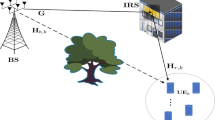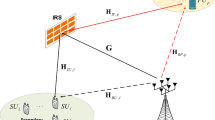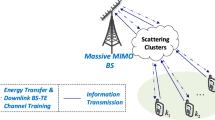Abstract
This paper studies the simultaneous wireless information and power transfer multi-antenna network with heterogeneous users and intelligent reflecting surface (IRS). Information decoding (ID) users, energy harvesting (EH) users, and power-splitting (PS) hybrid users require data and energy at the same time from the base station (BS) in the assistance of IRS. In the system model, the IRS reflects the incoming signal at each element by collaboratively adjusting phase shift to enhance the received signal at the users. In addition, the PS users exploit the PS circuit structure to simultaneously decode information and harvest energy via PS ratios. The target is to maximize the total PS-EH harvested power at PS and EH users with the non-linear EH model and limitation of BS transmit power while satisfying the signal-to-interference-plus-noise ratio requirements at ID and PS users. The information vectors at the BS, phase-shift vector at the IRS, and PS ratios at the hybrid users are jointly optimized by alternating optimization, semidefinite relaxation, sequential parametric convex approximation, and Gaussian randomization methods in the challenging non-convex problem. The numerical experiments present the convergence and effectiveness of the proposed algorithm. For certain parameters, the proposed IRS-assisted method enhances 17.65% total harvested power than the No-IRS one.













Similar content being viewed by others

References
Clerckx, B., Huang, K., Varshney, L. R., Ulukus, S., & Alouini. M. S. (2020). Wireless power transfer for future networks: Signal processing, machine learning, computing, and sensing [Online]. Available: arxiv: abs/2101.04810.
Wu, Q., Li, G. Y., Chen, W., Ng, D. W. K., & Schober, R. (2017). An overview of sustainable green 5G networks. IEEE Wireless Communications, 24(4), 72–80.
Bi, S., Ho, CK., Zhang, R. (2015). Wireless powered communication: Opportunities and challenges. IEEE Communications Magazine, 53(4), 117–125.
Qi., Q., Chen., X., Ng., D. W. K. (2020). Robust beamforming for NOMA-based cellular massive IoT with SWIPT. IEEE Transactions on Signal Processing, 68(211), 211–24.
Zhang, R., & Ho, C. K. (2013). MIMO broadcasting for simultaneous wireless information and power transfer. IEEE Transactions on Wireless Communications, 12(5), 1989–2001.
Clerckx, B., Zhang, R., Schober, R., Ng, D. W. K., Kim, D. I., & Poor, H. V. (2019). Fundamentals of wireless information and power transfer: From RF energy harvester models to signal and system designs. IEEE Journal on Selected Areas in Communications, 37(1), 4–33.
Boshkovska, E., Ng, D. W. K., Zlatanov, N., & Schober, R. (2015). Practical nonliner energy harvesting model and resource allocation for SWIPT systems. IEEE Communications Letter, 19(12), 2082–2085.
Xiong, K., Wang, B., & Liu, K. J. R. (2017). Rate-energy region of SWIPT for MIMO broadcasting under nonlinear energy harvesting model. IEEE Transactions on Wireless Communications, 16(8), 5147–5161.
Shen, C., Li, W. C., & Chang, T. H. (2014). Wireless information and energy transfer in multi-antenna interference channel. IEEE Transactions on Signal Processing, 62(23), 6249–6264.
Ding, Z., Zhong, C., Ng, D. W. K., Peng, M., Suraweera, H. A., Schober, R., & Poor, H. V. (2015). Application of Smart Antenna Technologies in Simultaneous Wireless Information and Power Transfer. IEEE Communications Magazine, 53(4), 86–93.
Wu, Q., & Zhang, R. (2020). Towards smart and reconfigurable environment: Intelligent reflecting surface aided wireless network. IEEE Communications Magazine, 58(1), 106–112.
Renzo, M. D., Zappone, A., Debbah, M., Alouini, M., Yuen, C., Rosny, J., & Tretyakov, S. (2020). Smart radio environments empowered by reconfigurable intelligent surfaces: How it works, state of research, and road ahead. IEEE Journal on Selected Areas in Communications, 38(11), 2450–2525.
Gong, S., Lu, X., Hoang, D. T., Niyato, D., Shu, L., Kim, D. I., & Liang, Y. C. (2020). Towards smart radio environment for wireless communications via intelligent reflecting surfaces: A comprehensive survey. IEEE Communications Surveys & Tutorials, 22(4), 2283–2314.
Pan, C., Ren, H., Wang, K., Elkashlan, M., Chen, M., Renzo, D. M., Hao, Y., Wang, J., Swindlehurst, A. L., You, X., & Hanzo, L. (2020). Reconfigurable intelligent surface for 6G and beyond: Motivations, principles, applications, and research directions. [Online]. Available: arxiv: abs/2011.04300.
Tang, W., Chen, M. Z., Dai, J. Y., Zeng, Y., Zhao, X., Jin, S., Cheng, Q., & Cui, T. J. (2020). Wireless communications with programmable metasurface: New paradigms, opportunities, and challenges on transceiver design. IEEE Wireless Communications, 27(2), 180–187.
Wu, Q., & Zhang, R. (2020). Weighted sum power maximization for intelligent reflecting surface aided SWIPT. IEEE Wireless Communications Letter, 9(5), 586–590.
Tang, Y., Ma, G., Xie, H., Xu, J., & Han, X. (2020). Joint transmit and reflective beamforming design for IRS-assisted multiuser MISO SWIPT systems. In IEEE International Conference on Communications (ICC), 1–6.
Liu, J., Xiong, K., Lu, Y., Ng, D. W. K., Zhong, Z., & Han, Z. (2020). Energy efficiency in secure IRS-Aided SWIPT. IEEE Wireless Communications Letter, 9(11), 1884–1888.
Wu, Q., & Zhang, R. (2020). Joint active and passive beamforming optimization for intelligent reflecting surface assisted SWIPT under QoS constraints. IEEE Journal on Selected Areas in Communications, 38(8), 1735–1748.
Xu, D., Yu, X., Jamali, V., Ng, D. W. K., & Schober, R. (2020). Resource allocation for large IRS-Assisted SWIPT systems with non-linear energy harvesting model. [Online]. Available: arxiv: abs/2010.00846.
Zargari, S., Khalili, A., & Zhang, R. (2021). Energy efficiency maximization via joint active and passive beamforming design for multiuser MISO IRS-aided SWIPT. IEEE Wireless Communications Letter, 10(3), 557–561.
Zargari, S., Khalili, A., Wu, Q., Mili, M. R., & Ng, D. W. K. (2021). Max-min fair energy-efficient beamforming design for intelligent reflecting surface-aided SWIPT systems with nonlinear energy harvesting model. IEEE Transactions on Vehicular Technology, 70(6), 5848–5864.
Li, Z., Chen, W., & Wu, Q. (2020). Joint beamforming design and power splitting optimization in IRS-assisted SWIPT NOMA networks. [Online]. Available: arxiv: abs/2011.14778.
Zou, Y., Gong, S., Xu, J., Cheng, W., Hoang, D. T., & Niyato, D. (2020). Joint energy beamforming and optimization for intelligent reflecting surface enhanced communications. In IEEE Wireless Communications and Networking Conference Workshops (WCNCW), 1–6.
Wu, Q., & Zhang, R. (2019). Intelligent reflecting surface enhanced wireless network via joint active and passive beamforming. IEEE Transactions on Wireless Communications, 18(11), 5394–5409.
Beck, A., Ben-Tal, A., & Tetruashvili, L. (2010). A sequential parametric convex approximation method with applications to nonconvex truss topology design problems. Journal of Global Optimization, 47(1), 29–51.
Grant, M., & Boyd, S. (2017). CVX: Matlab software for disciplined convex programming version 2.1., http://cvxr.com/cvx.
Karipidis, E., Sidiropoulos, N. D., & Luo, Z. Q. (2008). Quality of service and max-min fair transmit beamforming to multiple cochannel multicast groups. IEEE Transactions on Signal Processing, 56(3), 1268–1279.
Luo, Z. Q., Ma, W. K., So, A. M. C., Ye, Y., & Zhang, S. (2010). Semidefinite relaxation of quadratic optimization problems. IEEE Signal Processing Magazine, 27(3), 20–34.
Boyd, S., & Vandenberghe, L. (2004). Convex Optimization. Cambridge University Press.
Tuan, P. V., & Koo, I. (2017). Robust weighted sum harvested energy maximization for SWIPT cognitive radio networks based on particle swarm optimization. Sensors, 17(10), 2275.
Zargari, S., Farahmand, S., & Abolhassani, B. (2021). Joint design of transmit beamforming, IRS platform, and power splitting SWIPT receivers for downlink cellular multiuser MISO. Physical Communication, 48, 101413.
Banoth, S. P. R., Donta, P. K., & Amgoth, T. (2021). Dynamic mobile charger scheduling with partial charging strategy for WSNs using deep-Q-networks. Neural Computing and Applications, 33(22), 15267–15279.
Chu, Z., Hao, W., Xiao, P., & Shi, J. (2019). Intelligent reflecting surface aided multi-antenna secure transmission. IEEE Wireless Communications Letters, 9(1), 108–112.
Dong, L., & Wang, H. M. (2020). Secure MIMO transmission via intelligent reflecting surface. IEEE Wireless Communications Letters, 9(6), 787–790.
Yue, X., & Liu, Y. (2021). Performance analysis of intelligent reflecting surface assisted NOMA networks. IEEE Transactions on Wireless Communications. [Online] Available: https://doi.org/10.1109/TWC.2021.3114221.
Xing, Z., Wang, R., Wu, J., & Liu, E. (2021). Achievable rate analysis and phase shift optimization on intelligent reflecting surface with hardware impairments. IEEE Transactions on Wireless Communications, 20(9), 5514–5530.
Acknowledgements
This work was supported/partially supported by Hue University under the Core Research Program, Grant No. NCM.DHH.2022.08.
Author information
Authors and Affiliations
Corresponding author
Additional information
Publisher's Note
Springer Nature remains neutral with regard to jurisdictional claims in published maps and institutional affiliations.
Appendix: Obtaining the equivalent optimization problem (15)
Appendix: Obtaining the equivalent optimization problem (15)
To simplify the complex form of the objective function (14a), we utilize the new auxiliary variables \(\left\{ {{o_l},{{{\tilde{o}}}_j}} \right\}\) for replacing \(\left\{ {\mathrm{{HP}}_{\mathrm{{NL,}}l}^{\mathrm{{PS}}},\mathrm{{HP}}_{\mathrm{{NL,}}j}^{\mathrm{{EH}}}} \right\}\), and express the equivalent form as:
Then, we continue the simplified form of the new constraints (30b) as follows. By introducing new auxiliary variables, \({u_l} \ge 0,{v_l} \ge 0\), we replace \({e^{ - {a_l}\left( {\mathrm{{HP}}_l^{\mathrm{{PS}}} - {b_l}} \right) }}\) by \({u_l}\) and \(\mathrm{{HP}}_l^{\mathrm{{PS}}}\) by \(v_l^2\) in (30b). This results the equivalent form as:
Similarly, the equivalent form of the new constraint (30c) is expressed as:
Moreover, we take the function \(\ln \left( \cdot \right)\) for both sides in (31b) and (32b), thus achieve the equivalent optimization problem (15).
Rights and permissions
About this article
Cite this article
Tuan, P.V., Son, P.N. Intelligent reflecting surface assisted transceiver design optimization in non-linear SWIPT network with heterogeneous users. Wireless Netw 28, 1889–1908 (2022). https://doi.org/10.1007/s11276-022-02938-6
Accepted:
Published:
Issue Date:
DOI: https://doi.org/10.1007/s11276-022-02938-6



